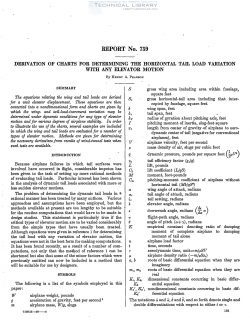naca-report-759

- Version
- 173 Downloads
- 1.33 MB File Size
- 1 File Count
- August 30, 2016 Create Date
- August 30, 2016 Last Updated
National Advisory Committee for Aeronautics, Report - Derivation of Charts for Determining the Horizontal Tail Load Variation with Elevator Motion

The equations relating the wing and tail loads are derived
for a unit elevator displacement. These equations are then
converted into a nondimensional form and charts are given by
which the wing- and tail-load—increment variation may be
determined under dynamic conditions for any type of elevator
motion and for various degrees of airplane stability. In order
to illustrate the use of the charts, several emamples are included
in which the wing and tail loads are evaluated for a number of
types of elevator motion. Methods are given for determining
the necessary derivatives from results of wind-tunnel tests when
such tests are available.
Because airplane failures in which tail surfaces were
involved have occurred in flight, considerable impetus has
been given to the task of setting up more rational methods
of evaluating tail loads. Particular interest has been shown
in the analysis of dynamic tail loads associated with more or
less sudden elevator motions.
The problem of determining the dynamic tail loads in a
rational manner has been treated by many authors. Various
approaches and assumptions have been employed, but the
methods available at present are too lengthy to be suitable
for the routine computations that would have to be made m
design studies. This statement is particularly true if the
critical types of elevator motion are to be varied considerably
from the simple types that have usually been treated.
Although equations were given in reference 1 for determining
the tail load with any variation of elevator motion, the
equations were not in the best form for making computations.
It has been found recently, as a result of a number of com-
putations, not only that the method of reference 1 can be
shortened but also that some of the minor factors which were
previously omitted can now be included in a method that
will be suitable for use by designers.
| File | Action |
|---|---|
| naca-report-759 Derivation of Charts for Determining the Horizontal Tail Load Variation with Elevator Motion.pdf | Download |

Comment On This Post